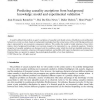2386 search results - page 140 / 478 » Representing and Reasoning with Preferences |
SPATIALCOGNITION
2000
Springer
15 years 1 months ago
2000
Springer
Since ancient times, people have devised cognitive artifacts to extend memory and ease information processing. Among them are graphics, which use elements and the spatial relations...
EMNLP
2008
14 years 11 months ago
2008
We consider a parsed text corpus as an instance of a labelled directed graph, where nodes represent words and weighted directed edges represent the syntactic relations between the...
107
click to vote
IJAR
2008
14 years 10 months ago
2008
A model is defined that predicts an agent's ascriptions of causality (and related notions of facilitation and justification) between two events in a chain, based on backgroun...
SEMWEB
2007
Springer
15 years 4 months ago
2007
Springer
Classical ontologies are not suitable to represent imprecise nor uncertain pieces of information. Fuzzy Description Logics were born to represent the former type of knowledge, but ...
GEOS
2005
Springer
15 years 3 months ago
2005
Springer
Continuously moving objects are prevalent in many domains. Although there have been attempts to combine both spatial and temporal relationships from a reasoning, a database, as wel...

